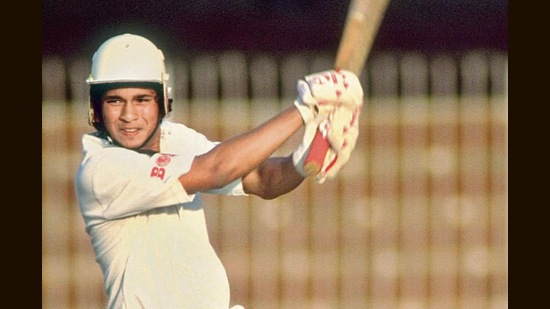The arrival of an Indian megastar
To understand the significance of November 15, 1989, in Indian sport, one can go back in time and scan the seasons prior to that date, or even go forward a few months
To understand the significance of November 15, 1989, in Indian sport, one can go back in time and scan the seasons prior to that date, or even go forward a few months. Doing both, and also noting a crucial call made two years earlier that encouraged the bold decision, will set the early story for a teenage prodigy who rose to become a phenomenon in world cricket.

First, forward. It’s the summer of 1990, and India are touring England. Having lost the first Test, it is vital to save the third to keep even slim hopes alive of salvaging the series. The signs though are ominous at Old Trafford as India’s top order has caved in.
Enter Sachin Tendulkar, all of 17. He goes on to score his maiden century, 119 not out, raising a crucial century partnership with Manoj Prabhakar to ensure a draw. It was the first of 100 international centuries he would go on to score, finishing a 24-year career with a slew of Test and ODI records.
August 1990 is important to get perspective on the previous winter.
The 16-year-old curly-haired boy from Mumbai, who had raised a sensational unbroken stand of 664 with Vinod Kambli — Tendulkar scored 326 not out and Kambli an unbeaten 349 — for Shardashram Vidyamandir, then scoring 500 runs at an average of 87.25 in his debut 1988 Ranji Trophy season.
That Raj Singh Dungarpur-headed national selection committee decided to throw the young Tendulkar into the deep end — a Pakistan tour is as tough as they come, especially for a teenager yet to experience international cricket — also in part was due to the search to find the next big batter after Sunil Gavaskar’s retirement in 1987.
Gavaskar, called to watch Tendulkar playing, had given his appreciation even before Mumbai pushed him into Ranji Trophy. But Pakistan’s fast bowlers, leave alone the challenge of facing India’s arch-rivals on their turf, would have been a daunting prospect even for an established player.
Tendulkar — who is still India’s youngest Test player aged 16 years and 205 days — proved his batting genius no doubt. But it was the courage he showed after being struck on the nose by a snorter from Waqar Younis in the fourth Test in Sialkot — he shook it off and hit a 57 that helped India draw the match — that defined what was to unfold rapidly for India and the cricket world.
“Devon and Waqar, during that phase, were easily the two quickest bowlers in the world bowling at 90mph. I didn’t call the physio as I didn’t want to show them that I am in pain. My pain threshold was fairly high. It’s okay to get hit. So what? You don’t show your pain to the bowler,” Tendulkar said in an interview to PTI in 2020, marking 20 years of his Old Trafford century.
Devon Malcolm had hit Tendulkar on the side of his head during that unbeaten 119 in the fourth innings when the 17-year-old announced himself as one for the long haul.
Tendulkar’s first innings, on his Test debut in Karachi, gave a sample of his class. He made only 15, but a sumptuous on-drive and a cut past point for two boundaries, both off fellow debutant Waqar Younis, laid the marker. Waqar won that first battle, Tendulkar beaten by the pace to be bowled as he tried to force through the on-side.
Waqar would draw blood after Tendulkar was hit on the bridge of his nose in the Sialkot Test, but he just washed it and resumed, smashing the next ball for four past mid-on. His first Test fifty had come in the second Test at Faisalabad (59), but this one would showcase the character of a player who went the longest distance in Test cricket.
“That was Sachin Tendulkar. A young man with guts, a young man who refuses to wilt under pressure and a young man who is unconcerned about the reputation of the bowler,” CS Rao would write in Hindustan Times. The Pakistan fans played on the term “little maestro”, which would stick to Tendulkar as he grew in stature, pronouncing that a “little monster” has arrived on the Indian cricket scene.
The “getting hit and shaking it off” defined Tendulkar as much as his astonishingly developed technique, eye, footwork and range of shots did in his initial months in international cricket.
Tendulkar explained in that 2020 interview how he had been prepared by his coach Ramakant Achrekar to surmount the kind of challenge which Waqar and Malcolm posed. Achrekar would make his young trainees practice and play matches on used pitches with uneven bounce at Mumbai’s Shivaji Park.
“In fact, (during fielding practice) I would just throw the ball up and take it on my body to absorb the pain,” Tendulkar would recall.
In his book ,Playing it May Way ,Tendulkar also speaks of the early anxiety after facing the fiery Imran Khan, Wasim Akram and Waqar Younis.
“It was baptism by fire. So much so that after my very first innings in Test cricket, during which I was all at sea against Wasim and Waqar, I began to doubt my ability to bat and question whether I was ever going to be good enough to play at international level,” Tendulkar writes.
He would go on to face Richard Hadlee-led New Zealand pace pack in early 1990, scoring 88 to prove he was no less a talent when it came to tackling swing. And Tendulkar would simply go on to symbolise pretty much everything about Indian cricket from there.





